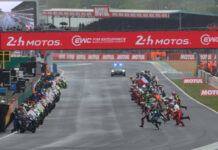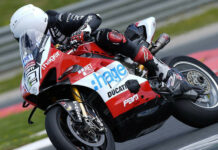A love of motorcycles that started with riding street bikes led to Ichiro Yoda taking up a job with Yamaha immediately after graduating from Tokyo’s Metropolitan University at the end of the seventies. Yoda’s first project for his new employer was a single-cylinder machine designed for the Middle Eastern market; a far cry from the high-tech MotoGP machines he would work on in the future. But it was not long before Yoda made the switch to the racing department, where he was involved in projects as varied as a four-stroke 500GP machine and a 1000cc endurance racer, both of which were tested but never raced. Yoda also worked on the development of the OW61 500GP engine campaigned by Kenny Roberts, before taking over as project leader on the YZR250 machine that Venezuelan rider, Carlos Lavado, took to the World Championship title in its debut season. In 1994 Yoda returned to Japan to work on the 500GP project, but switched back to the quarter litre class in 1998 to win the All Japan Championship with a young Shinya Nakano. Yoda returned to Europe in 2000, with Olivier Jacque and Shinya Nakano finishing the season first and second in the 250cc World Championship standings aboard the bike that he had developed and built. Yoda joined KHI as MotoGP Technical Director at the start of the 2005 season, after spending his last four years with Yamaha heavily involved in the development of their YZR-M1 MotoGP racer. Q: After more than 20 years with the company your name is almost synonymous with Yamaha. Why did you make the decision to switch allegiance to Kawasaki after such a long time with one manufacturer? A: Basically I wanted a new challenge, which is why I quit Yamaha at the end of last year. I wanted to stay in racing, because I enjoy working in this environment and this is where my experience lies, so when Kawasaki approached me about working on the Ninja ZX-RR project I was very interested. After visiting KHI I decided that this is what I wanted to do; it was the new challenge I had been looking for. Q: Will you base yourself in Europe this year, or do you feel it’s more important to be involved closely in the development programme in Japan? A: The development work will be done mostly in Japan, using the data collected at races and tests, so that’s where I’ll be based. After each race or test I will return to Japan to continue the development work alongside the KHI engineers. Q: You’ve only been with Kawasaki for a very short time, but what are your first impressions of the company as a whole and the Kawasaki Racing Team in particular? A: Kawasaki Heavy Industries is a big company that produces many products, not just consumer products like motorcycles. They are involved in engineering projects in a wide variety of areas, from aerospace to shipbuilding. This involvement in such a range of engineering projects means that KHI has a good level of engineering expertise in many disciplines. And while the number of people working on the MotoGP project is only small compared to other projects, I believe we have the engineers necessary to make the Ninja ZX-RR a success. The Kawasaki Racing Team has a lot of experienced and well-motivated people. Everyone in the team has the same goal of improving our results on the track. It is a good environment in which to work and I think there is great potential for the future. Q: You’ve worked closely with both Shinya Nakano and his crew chief, Fiorenzo Fanali, in the past. Do you think already having a good working relationship with key people in the team makes the job of developing the Ninja ZX-RR any easier? A: Definitely, because we have worked together in the past it is very easy for Shinya, Fiorenzo and myself to exchange ideas and communicate our opinions on the development of the bike, and this speeds up the whole development process. Q: The development of the 2005 Ninja ZX-RR was well underway by the time you joined Kawasaki. Will you have a major input on the continued development of this year’s bike, or is your focus more on the 2006 season and the next variant of the Ninja ZX-RR MotoGP machine? A: Of course, I have to look to the future, but I also need to develop the bike we have now because this is the bike we will race this season. The tests we’ve done so far this year have allowed us to identify very clearly the development direction we need to take with this bike, and what the requirements are for the first race. I think that, with this knowledge, we will be in a position to achieve some good results by the midpoint of the season. Development can also be dictated by your competitors; if they’ve made significant advances during the winter months then your own development programme has to be flexible enough to reflect this if you are to remain competitive. It may be that we have to revise our development plan when we see what level our competitors have attained going into the new season. Q: It’s no secret that Kawasaki have been running a ‘big bang’ version of the Ninja ZX-RR engine during pre-season testing, but what advantage does running a revised firing order have over the more conventional ‘screamer’ engine? A: we can see some advantages already by looking at the data, but it’s equally as important for us to listen to the feedback we get from the riders. From the comments Shinya has made during testing it seems that the big bang engine makes it easier for him to control the bike, especially when the performance of the tyre starts to drop off, which it obviously does towards the end of a race. These four-stroke MotoGP engines produce a lot of power, but this power has to be transferred to the track and that is where the power characteristics of the big bang engine offer an advantage over the screamer motor. The way that the big bang engine delivers its power is better for the rear tyre, which can easily be overwhelmed by the more aggressive, peakier delivery of the screamer engine. Basically, the big bang engine allows us to make maximum use of the grip available from the rear tyre, and this has a noticeable affect on lap times. Q. There have obviously been some big changes in the engine department, but what of the chassis? Have there been any major revisions in this area over the winter months? A: We wanted to keep the basic chassis from 2004, as we have a good understanding of how this chassis works. Because we know how the chassis performs at the circuits we’ve tested at so far this year, we can see straight away the affect that the new engine has on the bike as a whole. I think we will only make some very small changes to the chassis this year, as we need to focus our resources on developing the engine. Q. Shinya Nakano has the smooth style typical of riders who cut their teeth in the quarter litre class, whereas Alex Hofmann has a more aggressive style on the bike. The two also have very different physical characteristics; Shinya is small and light while Alex is tall and 20kg heavier than his Kawasaki teammate. How difficult is to develop a bike that is suitable for two riders who differ to such an extent? A: It is sometimes difficult to change the basic ergonomics of the bike to suit the physical characteristics of both riders, but we have managed to do this with the Ninja ZX-RR. Once we’ve identified a good base setting on the bike I think both riders will be able to fine-tune their individual set up to suit their physical characteristics and their individual riding styles. In terms of the engine, if we can provide as smooth a power delivery as possible then I think this will suit both riders. I don’t believe a difference in riding styles really has any affect on the direction we take with the development of the engine. Q: On the strength of what you’ve seen of the Ninja ZX-RR and the Kawasaki Racing Team’s two riders during pre-season testing, what are your goals in terms of results this season? A: Racing is winning, so we must always aim to win. We’re not here just to make up the numbers, so it is important that we have a clear goal, and I like to keep our goals and targets high. First we must develop the bike into a race-winner and then we must put riders on the bike who are capable of winning races. If we can do this then I think we will see some good results this season. Q: Kawasaki originally came into MotoGP with a five-year plan that would see them challenging for the World Championship title in 2007. Do you see this as a realistic goal based in your experiences so far? A: Yes, I think this is a realistic aim, and this is what we are working towards with our development programme.
An Interview With Kawasaki MotoGP Technical Director Ichiro Yoda
An Interview With Kawasaki MotoGP Technical Director Ichiro Yoda
© 2005, Roadracing World Publishing, Inc.






